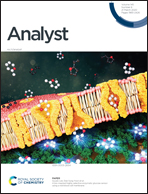Smilax China-derived yellow-fluorescent carbon dots for temperature sensing, Cu2+ detection and cell imaging†
Abstract
Here, we report an environmentally friendly fabrication strategy of bright yellow fluorescent carbon dots (y-CDs) and construct a rapid and accurate multifunctional sensing platform for the effective detection of temperature and Cu2+. The y-CDs were favorably obtained through a one-step hydrothermal treatment of natural Smilax China for the first time and exhibit long-wavelength emission at 542 nm under an excitation wavelength of 470 nm. Additionally, the obtained y-CDs exhibit superior biocompatibility and distinguished stability under different conditions, and display a respectable fluorescence quantum yield of up to 22.37%. Appealingly, the as-prepared y-CDs were implemented as temperature probes within ranges of 25 °C–40 °C and 45 °C–80 °C. Significantly, based on the static quenching effect, the as-prepared y-CDs were developed as an effective platform for fluorescence sensing of Cu2+, with linear ranges of 0.5 μM–10 μM, 75 μM–225 μM and 250 μM–350 μM, achieving a detection limit of 28 nM. Furthermore, confocal fluorescence imaging of PC12 cells was achieved successfully, which indicated that the as-synthesized y-CDs could visualize Cu2+ fluctuations in living cells.



 Please wait while we load your content...
Please wait while we load your content...